Ginger plants are becoming famous due to their ability to increase taste in dishes and treat various health issues. But how do we grow them to get these benefits? Today, we will talk about when and how to grow ginger roots.
The best time to plant ginger roots is in the late winter or early spring when the frost is over. However, check the frost period of your area. If your region is prone to late frost, ginger roots won’t develop. Late planting results in late harvest, but early planting causes rotting.
This guide will help you know when to plant the ginger roots so that you get good ginger and harvest them at the right time. We will also share the steps for growing the ginger roots successfully.
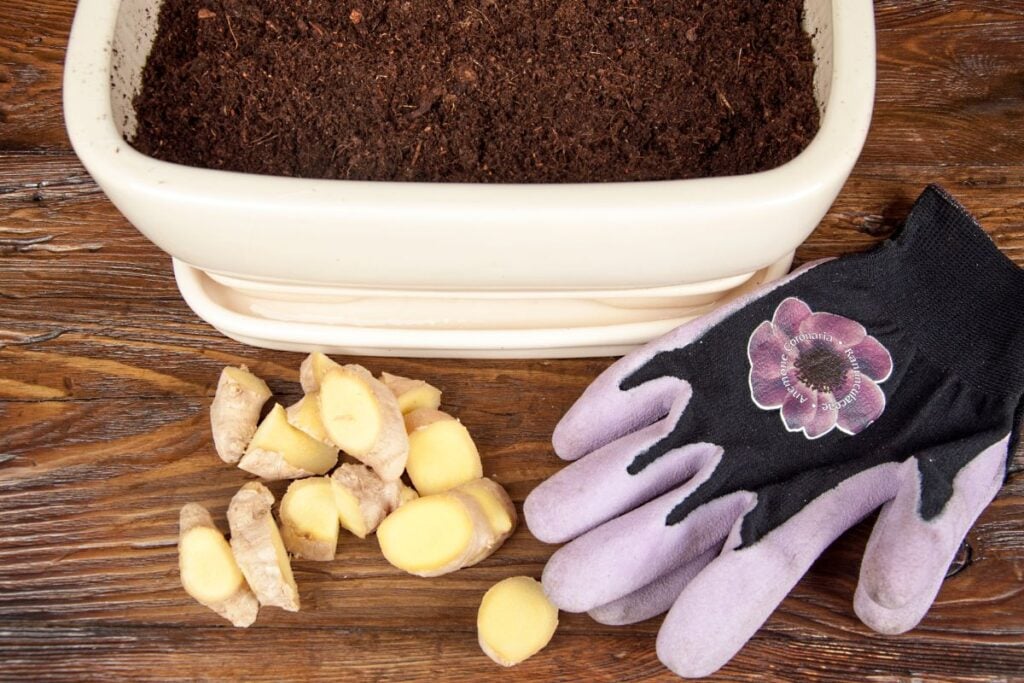
What is the difference between ginger and ginger roots?
Before I get into the main topic, I would like to share the difference between ginger and ginger roots.
Ginger is a root plant that belongs to the Zingiberaceae family.
It includes the plant, the rhizomes, and even the processed ginger, i.e., the powder.
Ginger root is the raw root or rhizome part harvested and used for culinary and health purposes.
It is only fresh raw ginger and is also used for growing ginger.
When is the best time to plant ginger roots?
Ginger needs a hot and humid climate to grow.
Depending on the seasons, the best time for planting the ginger roots is early spring.
Do not plant them too early or too late.
They develop best in the summer.
If you plant them in the early spring, ginger prepares for harvest in the late summer.
You can keep them for a longer period until the fall, provided the weather is very cold.
But harvest them before the frost arrives.
The ginger pieces will probably suffer root or rhizome rot if you plant them too early.
If you plant them too late, there will be no harvest before the first frost.
Planting at the wrong time of the year results in a poor harvest.
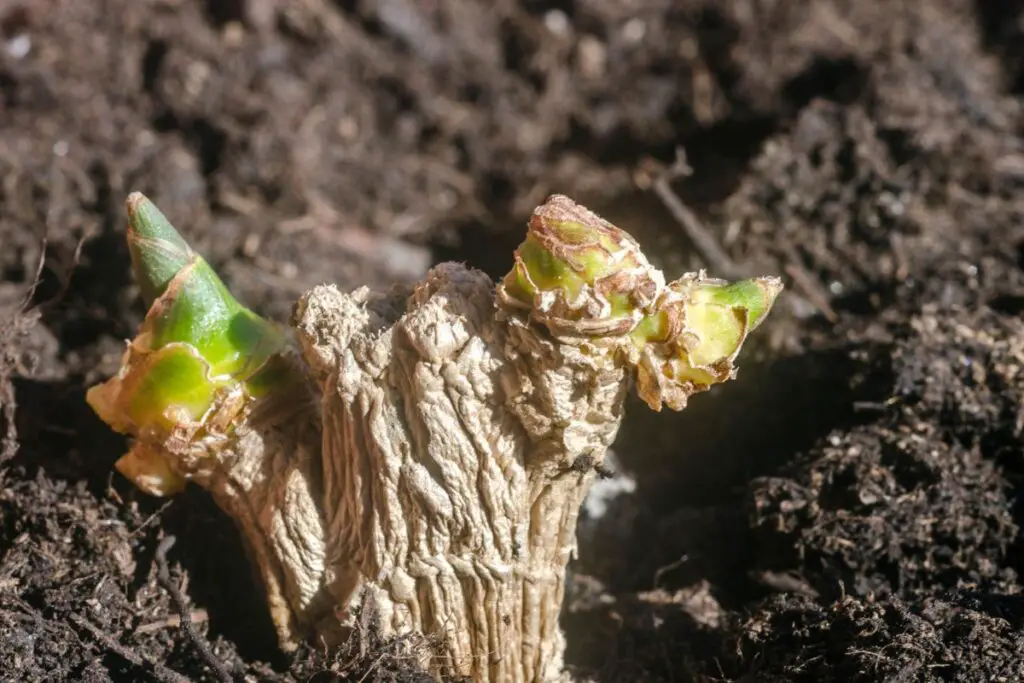
You can also plant the ginger roots in the late spring or early summer.
It is the time when the temperature remains a little more hot and humid compared to the early spring.
Late winter is also a good time as it is the time when the temperature of the soil starts getting warm.
Fall is not a good time to plant ginger roots.
There could be risks of frost, rather early frost, and the tender ginger roots will suffer cold damage and fail to sprout out at the right time.
So, avoid fall planting.
Avoid mid-summer or late summer planting because it is the time when ginger develops at its best.
Ginger takes at least 8-10 months to reach maturity.
Planting them in summer won’t increase their growth much.
If you plant them late, the ginger won’t get ready for harvest before the first frost.
Even if they do, it will be poor.
So, the best times for planting the ginger roots are:
- Early or late spring
- Early summer
- Late winter
Depending on the temperature, the best time to plant ginger is when the soil temperature is around 75°F.
So, whatever season you choose, you must ensure that the soil temperature remains around 75°F.
If you wish to grow ginger in colder climates, there are two types of cold-hardy ginger to plant in the early spring.
The first one is Canadian wild ginger.
They are native to zone 3.
The second one is Asian ginger which is native to zone 4.
If you belong to warmer zones, you can plant them anytime when the soil temperature is around 75°F.
How to plant ginger roots?
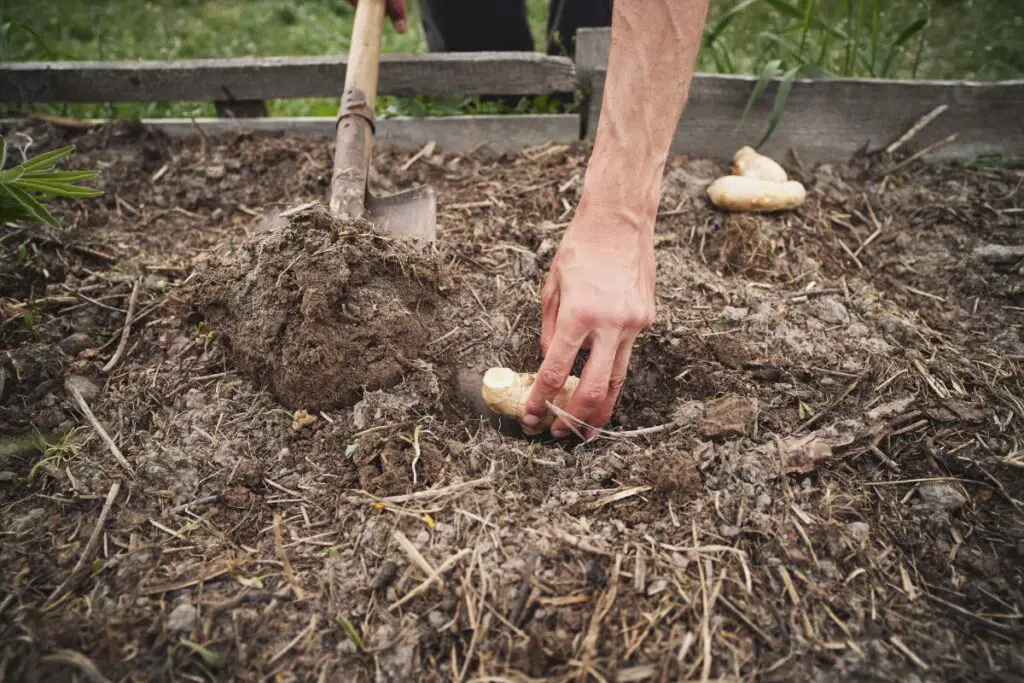
Planting ginger roots is not a very tough task.
But before you plant the ginger roots, you must encourage them to sprout some roots.
Looking for gardening supplies? We have tested 100's of products before recommending them to you guys. Check out our best pick below:
| Image | Gardening Supplies | Best Price? |
|---|---|---|
 Top
Top Top
Top | Raised Garden Bed Kit | Check On Amazon |
 | XLUX Soil Moisture Meter, Plant Water Monitor, Soil Hygrometer Sensor for Gardening, Farming, Indoor and Outdoor Plants, No Batteries Required | No Results |
 Top
Top Top
Top | 82 Pcs Garden Tools Set and Extra Succulent Tools Set | Check On Amazon |
 | Joeys Garden Expandable Garden Hose with 8 Function Hose Nozzle, Lightweight Anti-Kink Flexible Garden Hoses, Extra Strength Fabric with Double Latex Core, (50 FT, Black) | No Results |
 Top
Top Top
Top | Dual Chamber Compost Tumbler | Check On Amazon |
 Top
Top Top
Top | Sunnyglade Plant Stakes | Check On Amazon |
 Top
Top Top
Top | Organic Cold Pressed Neem Seed Oil | Check On Amazon |
 Top
Top Top
Top | Mighty Mint Gallon :-Insect and Pest Control Peppermint Oil | Check On Amazon |
 Top
Top Top
Top | Scotts DiseaseEx Lawn Fungicide | Check On Amazon |
 Top
Top Top
Top | Jacks Classic 20-20-20 All Purpose Fertilizer | Check On Amazon |
 Top
Top Top
Top | 30,000 Seeds Pollinator Attracting Wildflower Mixture | Check On Amazon |
 Top
Top Top
Top | Survival Vegetable Seeds Garden Kit-Over 16,000 Seeds | Check On Amazon |
Sprouting the ginger roots for planting
Choosing healthy gingers and not frozen, dried, or damaged ones would be best.
It should be big, smooth, and healthy and must have eyes or nodes from where the ginger will sprout.
After collecting the gingers, leave them at a location full of moisture to stimulate the rhizome growth.
For this, keep the ginger root pieces in a glass of water for 3-4 hours.
After that, remove the roots and keep them on tissue or water absorbent paper to release the moisture.
After some time, keep the ginger pieces in a plastic zipper bag and wrap the bag in a cloth.
Monitor the ginger roots and check whether they are sprouting roots or not.
Expect sprouting most probably after 1-2 weeks.
The ginger roots will also have some small thin roots and green bumps from the nodes where the plant will come out and grow.
Sprouting helps you notice the nodes or eyes and speeds up the growth process.
A step-by-step guide to growing ginger root
While growing ginger plants, you must follow the steps to get healthy ginger.
Once you know the step-by-step guide, it will be easy for you to grow them.
Materials
- A healthy, big, and smooth-textured ginger rhizome
- Compost to amend the soil before planting
- A pot if you want to start ginger in pots
Steps
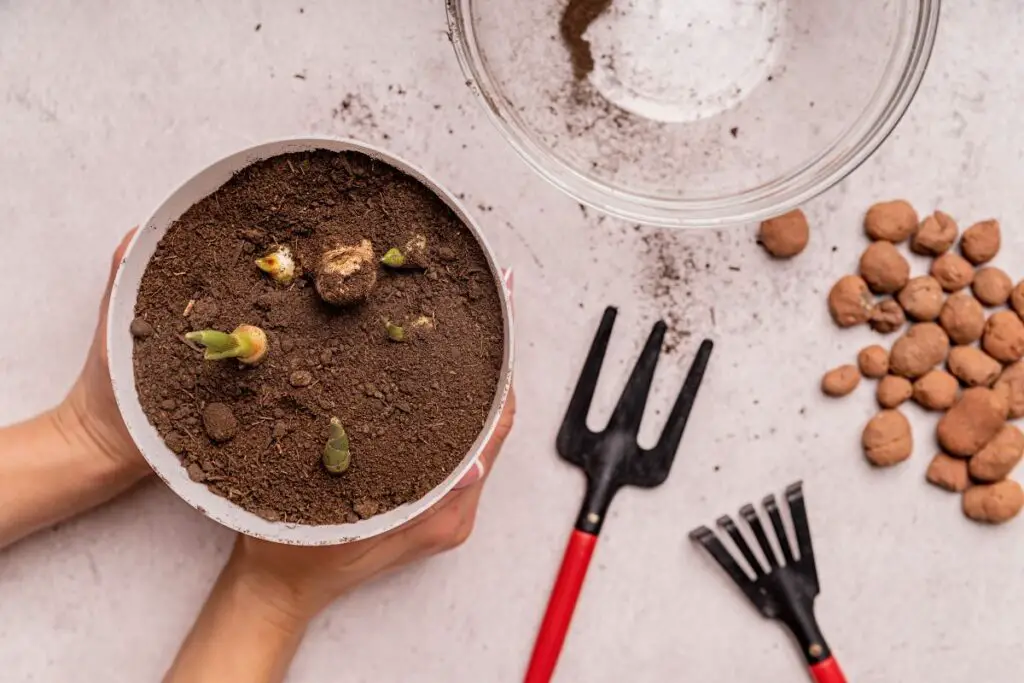
Now, I will explain the steps to help you understand them better, especially the beginners.
- Break or cut the ginger roots into pieces without hurting the roots and green buds. Each piece should be at least 1 to 1.5 inches wide and have at least one sprout.
- Allow the cut areas to form callus for 1-2 days.
- Once they are healed, prepare the soil bed for planting. Till 6 inches of the topsoil and add compost or slow-release fertilizer.
- Take a shallow and broad pot if you use pots to plant the ginger plants. Make sure it has drainage holes.
- Prepare the soil as loamy, well-drained, moisture-retentive, and organic. Ginger roots enjoy damp and fertile soil that drains well but remains moist, not soggy.
- Select a location that gets filtered sunlight or partial or full shade. Never plant the ginger roots under direct sunlight. It will affect the growth, and the plant will never sprout.
- Make a hole and place the ginger into the soil and bury it. Place the ginger root horizontally, with the nodes or eyes facing upwards. The node is the place from where the green buds have sprouted.
- Plant the ginger pieces 2-4 inches deep and 5-15 inches apart.
- Water the soil after planting deeply to moisten the soil and the ginger roots. Please don’t put the soil over the rhizome but around it.
- Ensure that the soil temperature is around 75°F and the surrounding temperature is around 68-70°F.
What are the best conditions for ginger root to grow?
Most of the ginger varieties are ideal for zones 9-12.
But, some varieties are native to zone 7, and some are hardy to zone 3-4.
If you are growing ginger in zones 7-8, you have to harvest them before the fall because there are chances of rotting due to cool and damp winters.
If you belong to zone 9-12, you may harvest them anytime.
You need to follow the right conditions if you want healthy, tasty, and big ginger rhizomes from your planted ginger roots.
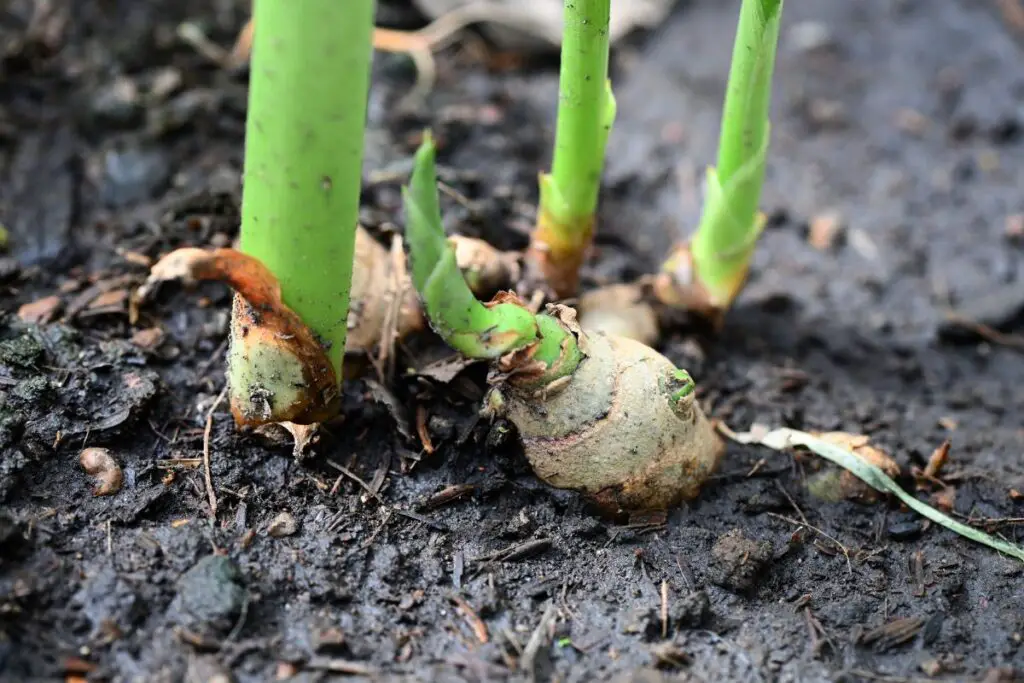
Here is a brief about the best conditions for ginger roots:
- Ginger won’t tolerate sunny locations. They survive best when they receive filtered sunlight throughout the year, dappled sun for 2-5 hours, or direct sun for only 2 hours.
- Water the plant generously to keep the soil moist most of the time. Don’t wait for the whole soil to dry out. However, they won’t enjoy their feet drowning in a pool of water. Let the soil surface dry before you water them.
- The best soil for ginger plants is loamy, moisture-retentive, well-drained, and fertile soil. It keeps the soil loose, thus allowing the water to seep through the roots, draining the excess water, and allowing air to enter the roots. The pH should be around 5.5-6.5.
- Ginger plants are heavy feeders. Fertilize at the time of planting with compost or slow-release fertilizers. After that, feed them with a liquid fertilizer when new shoots appear every month in spring and summer. When the flower appears, stop feeding and use potassium for plump and juicy ginger roots.
- Ginger plants need warm temperatures to grow well. When planted in the early spring, ginger roots develop best when summer arrives. The temperature should not drop below 50°F. Otherwise, they will receive frost damage and kill the entire plant.
- Ginger plants need at least 70-80% humidity levels for better development. Ginger plants will benefit from daily misting.
Ginger plants don’t require any other maintenance.
You may add mulch after new shoots appear and in winter to prevent quick moisture evaporation, weed growth, and frost damage.
Final thoughts
Growing ginger roots is not a very tough job. The best time to plant the ginger roots is in early or late spring, late winter, or early summer. It is when the temperature starts warming up and, thus, best for ginger growth.
While planting, assure that the soil temperature remains around 75°F. If planted in the early spring, ginger prepares for harvest before the frost. If you are too early, the roots may rot, and you get a poor harvest if you are too late. Follow the planting steps properly to get better ginger plants.
Maintain filtered sun, moist fertile and well-drained soil, regular fertilization, warm temperatures, high humidity, and mulching to help thrive the plants.
FAQs
Can I grow ginger from store-bought ginger roots?
You can grow ginger from the store-bought ginger roots.
But, there might be inconsistencies because these gingers might be sprayed with growth inhibitors to stay healthy and big.
This product prevents the rhizome from sprouting.
Soak them overnight in water to get positive results, or buy organic ginger.
Reference: Ginger Production, Texas AgriLife Extension, USDA, Wikipedia
